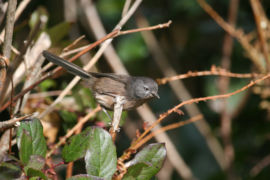Wrentit
Conservation status Least concern |

|
|
Scientific classification |
|
|
|
Binomial name |
Chamaea fasciata
(Gambel,
1845) |
The Wrentit, Chamaea fasciata, is a small
bird that lives in chaparral and bushland. It is the
only species in the genus Chamaea (Gambel, 1847).
It is the subject of much taxonomic debate, having been
placed in many different families by different authors for
as long as it has been known to science. Its name reflects
the uncertainty, and its resemblance to both tits and
wrens.
The Wrentit has been variously placed in its own family,
the Chamaeidae, with the
bushtits (Aegithalidae), the tits and chickadees (Paridae),
the
Old World warblers (Sylviidae), and most recently with
the Old World babblers (Timaliidae). The AOU places the
Wrentit in the latter family, giving it the distinction of
being the only babbler known from the New World.
Description
The Wrentit is a small (15-cm) bird with uniform dull
olive, brown, or grayish
plumage. It has short wings and a long tail often held
high (hence the comparison to wrens). It has a short bill
and a pale iris. Given its retiring nature and loud voice,
the Wrentit is more likely to be detected by its call than
by sight.
Behavior and Range
The Wrentit is a sedentary (non-migratory)
resident of a narrow strip of coastal habitat in western
coast of North America, being found from Washington south to
Baja California. It is usually restricted to scrub and
certain types of woodland. It nests in 1m high shrubs such
as poison oak, coyote bush and Californian blackberry. Logging and other changes in
habitat have led to this species expanding its range
recently, particularly northwards.
Wrentits mate for life, forming pair bonds only a few
months after hatching. Both sexes participate in building
the nest, a four-stage process that takes about two weeks.
The three or four eggs are incubated for 14 days, again by
both sexes. The chicks
fledge after 15 days (at which stage they are unable to
fly) and are fed by their parents for another 40 days.
The Wrentit feeds by skulking through dense scrub
gleaning exposed insects found by sight. It feeds primarily
on beetles, caterpillars, bugs, and ants,
but also takes small berries and seeds.
References
- BirdLife International (2004).
Chamaea fasciata. 2006
IUCN Red List of Threatened Species. IUCN 2006. Retrieved on 05 May 2006. Database entry
includes justification for why this species is of least
concern
- Geupel, G. R., and G. Ballard. 2002. Wrentit (Chamaea
fasciata) in The Birds of North America, vol.
17, no. 654 (A. Poole and F. Gill, eds.). The Birds of
North America, Inc., Philadelphia, PA.




